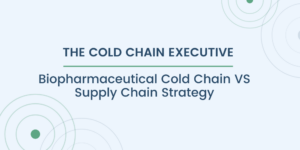Part 2: Expanding Shipping Temperatures Without Sacrificing Quality: A Guide to Transport Validation and PQ
Demonstrating Product Quality All pharmaceutical manufacturers must ensure that the safety and efficacy of...
read Details

The reality of being a C-Suite or senior executive Biopharmaceutical leader is that you don’t need to know every detail about the underlying engineering, mathematical formulas, and regulatory guidances that are used to validate your cold chain. That’s why Modality Solutions created the Cold Chain Executive – a subscription-based series providing key insights that directly address the cold chain challenges and strategies you need to know.
>> Subscribe to be notified about new Cold Chain Executive resources
A cold chain strategy for biopharmaceuticals is a set of procedures and systems that ensure that temperature-sensitive drugs are stored and transported at the correct temperature at all times. This is important because biopharmaceuticals can lose their potency or become unsafe if they are not stored at the correct temperature throughout the supply chain. The intricate nature of biopharmaceuticals necessitates a comprehensive cold chain strategy that safeguards their quality, efficacy, and safety.
The cold chain strategy should be tailored to the specific needs of the biopharmaceutical product. For example, some products may require storage at a very cold temperature, such as -80°C, while others may only need to be stored at a refrigerated temperature, such as 2-8°C.
Each cold chain strategy should take into account the different stages of the product’s lifecycle, the network from manufacturing to distribution to storage at the point of care. At each stage, there are potential risks to product quality, and these risks need to be mitigated.
The key differences between a biopharmaceutical cold chain strategy and a supply chain strategy are as follows:
Overall, a well-designed and executed cold chain strategy is crucial for biopharmaceutical manufacturers to ensure the integrity, efficacy, and safety of temperature-sensitive drugs throughout their supply chain. The complexity and sensitivity of biopharmaceuticals demand a tailored approach that addresses specific temperature requirements, mitigates risks at each stage of the product’s lifecycle, and complies with rigorous regulatory standards. Unlike a traditional supply chain strategy, a biopharmaceutical cold chain strategy emphasizes temperature control, security, regulatory compliance, and higher associated costs. By prioritizing these factors and implementing effective procedures and systems, biopharmaceutical professionals can safeguard product quality, enhance patient safety, and maintain a competitive edge in the evolving landscape of advanced therapeutics.
Modality Solutions is a leading provider of innovative and comprehensive solutions for the biopharmaceutical industry. Our team of experts has extensive experience in the industry and works closely with national and international regulators to ensure that our clients stay ahead of the latest industry developments and best practices. We pride ourselves in providing tailored solutions to meet the unique needs of our clients, and we are committed to helping organizations achieve their goals. Contact us for more information on how we can help your organization navigate the complex world of biopharmaceutical transportation. And don’t forget to follow us on LinkedIn to stay updated on our latest developments.
Subscribe for more executive cold chain insights:
Demonstrating Product Quality All pharmaceutical manufacturers must ensure that the safety and efficacy of...
read Details
Introduction The integrity of supply chain management is pivotal in the demanding realm of...
read Details
Entering the U.S. market comes with a unique set of regulatory challenges, particularly when...
read Details